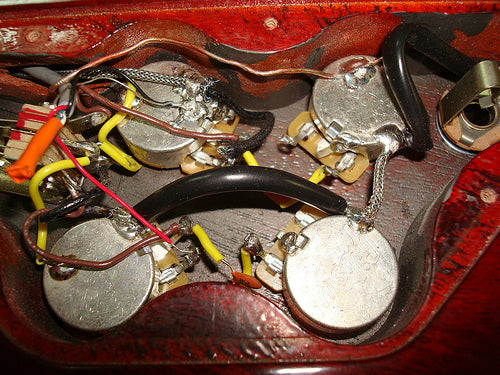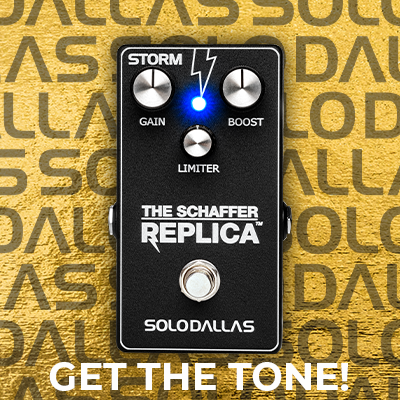So, I’ve noticed alot of you have been asking Fil the same question that I had been for a while. ” What is the 50’s wiring you’ve been talking about?” Well here I’ll not only show you what it is, I’ll show you how to do it!!! In my research I found that there are more than one 50’s wiring styles. This one, however, is the most common and simple. This will be sort of a two part thing. I’ll show, in the simplest fashion, how to switch your existing wiring to the 50’s style. For me, this wasn’t enough. (I think we’ve learned I can’t leave things “stock” by now ?? ) Next I’ll show how to do a complete “vintage” style rewire.
To explain a little, newer Gibsons like mine (2006) come with thin wiring and VERY SMALL “pill” capacitors. Even after I switched my SG to the 50’s style it didn’t clean up as well as I’d heard and seen in Fil’s video’s. So, off to the guitar geek forums I went. (no offence, I’m one too ?? ) It was then I found the problem. On top of the sub-quality wiring (as compared to true vintage) Gibson has been using different pot values in the more current Guitars. Mine tested out to be 4OOkO for tone pots and 3OOkO for volume. So I decided to do a complete rewire with 5OOkO pots, thicker cloth covered wire and a more vintage style Oil Filled capacitor. For those of you with even newer models (I believe ’08 and newer) it’s a different ball game. Gibson has been using printed circuit boards. I don’t know if it’s in all new models or just some but if you want the 50’s wiring I believe the complete rewire is the best option.
Part Supply Link: http://www.mojotone.com
Cost: Less than $50 USD
Since I forgot to take a “before” picture of mine, here is my brother-in-law’s 2004 SG. Completely un-molested, stock Gibson new style wiring.
Note that the capacitors connect to the same lug as the hot pickup wire on the volume pot.
Here is my SG after I initially switched to 50’s wiring. Note the new position of the capacitor lead on the vol. pot. Moved to the center lug.
(See how much bigger the control cavity is on the ’04 as compared to my ’06?)
So there’s the simple explanation. Easy as moving a single capicitor lead. Be very careful though. Those cap. leads bend and break very easily. Also be sure not to overheat the components.
The rest of this article will be covering a complete re-wire for the more adventurous of us here.
Here’s the basic tool set for this project. My soldering iron is an adjustable temp. iron. I recommend one like this. You can use the lower setting (20watt) for the smaller things that can easily overheat and the higher (50watt) for bigger things like pickup covers and pot grounds. You need the high heat for pots so you don’t have to heat the back so long that you boil the inside parts. IN-&-OUT fast is what you want.
No matter what gauge solder you use it always should be 60/40 Rosin Core. I use the .032" dia.
A couple of quick terms for those new to soldering.
TINING: Tining is the main prep for the soldering iron and the wire. For the iron: let it get to full temp and coat the tip with solder. For the wire: use the iron to heat the wire until the solder flows in easily. Tin ALL wires prior to soldering them into place.
De-Solder:The blue tool above is a solder sucker. You NEVER want to reuse solder. This tool will quickly remove the old once heated.
Heat Sink: An object, such as an alligator clip, installed between the solder point and the fragile component to absorb damaging heat during soldering.
For those of you not wanting to hurt your finish this is a simple splat guard made from a cereal box. It only takes about 5 min. to make and install.
So here’s one of the main goals to this rewire. Getting rid of these tiny ceramic pill caps. These are the main reason the “vol clean-up” wasn’t as expected.
The first step is to de-solder all of the pickup leads and the ground wire and push them up out of the way. If you have pickups with identical leads, be sure to mark which was the bridge or neck for re-install later. The one seen here with the multi leads is my Angus sig. pickup. (installed sloppy) ??
If your knobs don’t easily pull off try this. Any strong shoe string works. Also I recommend making a cover to protect the finish when removing the switch washer.
After removal of the harness. If you are going to re-use any parts (switch, jack, ect…) de-solder them now and set them aside.
Rather than do all of this heavy soldering in the small control cavity. I chose to make this simple template. I used my cavity cover for the outline and simply traced the hole locations. This can be made out of almost anything. I chose 1/4' plywood for it’s similarity to the guitar material.
Next is to mount your main pieces. Try to get them as close as you can to how they will sit in the cavity. Just use a LITTLE extra wiring to allow some adjustment when you install the harness. The first to do here is to solder the ground lugs to the pot back. Take some sandpaper to lightly sand the pot surface before soldering. This will give the solder more to grab on to.
Here is the example of a heat sink. Placing the clip between the soldering point and the component will reduce the heat reaching the component.
Here is the finished harness on the template. When I do these I try to start with the lowest wires working my way up through the harness. It seems to make it so there’s less in the way. (If wire routs are to hard to see here there are alternate views at my Flickr page. See the link at the end of the post for my account page.)
After the harness has been transferred to the control cavity tighten all of the components down into their final position. Last to do is solder in the pickups and ground wire. Congrats!!!! You’re done and ready to ROCK!!!!
Here’s the before & after for my SG. These caps are oil filled and are specifically made to replicate the “bumblebee” caps used on vintage models.
I took the opportunity to clean up my crappy wiring on the A.Y. Sig. tucking the unused coil-tap wires into the black sleeve.
Here’s the before & after on the bro-in-law’s SG. These caps are a metal film. They are made as a direct replacement for the famous “mustard” caps.
(Note, on both guitars, that Gibson only solders the ground wire to the Neck Tone pot only. Whether it be necessary, or not, I solder it to both neck pots to have a more complete ground loop. I also run the main ground loop separate from the hot input jack wire coming off of the switch, as opposed to the braided shield Gibson used to “combo” the two.)
This is the diagram Fil led me to. You can find it at the following link along with some alternate ’50’s versions and others.
http://www.mylespaul.com/forums/tonefreaks/558-wiring-library.html
This is another helpful link for wiring. Seymour Duncan. Many different combos.
http://www.seymourduncan.com/support/wiring-diagrams/
As usual if you have any questions feel free to ask. And again for alternate views and full pic. size, see them here:
http://www.flickr.com/photos/55720588@N03/
Until the next post…… ??


